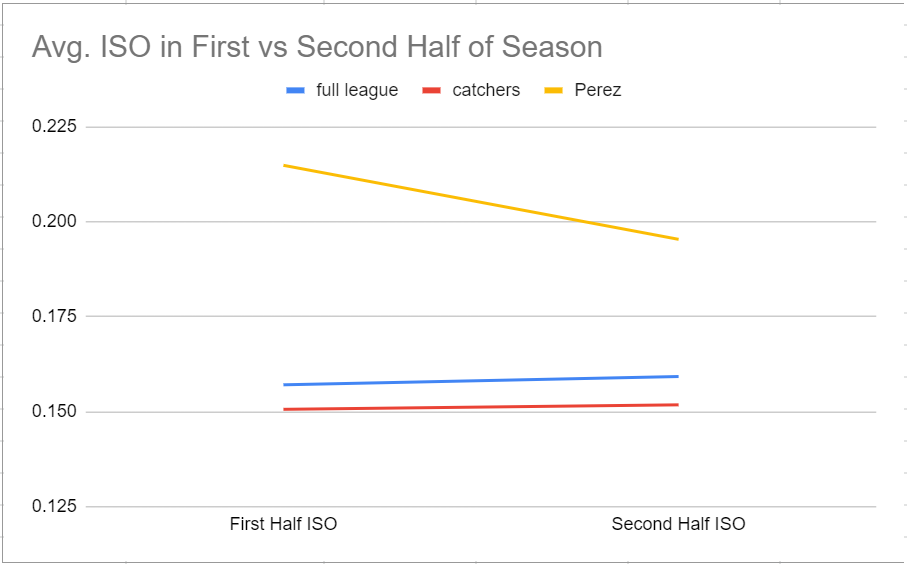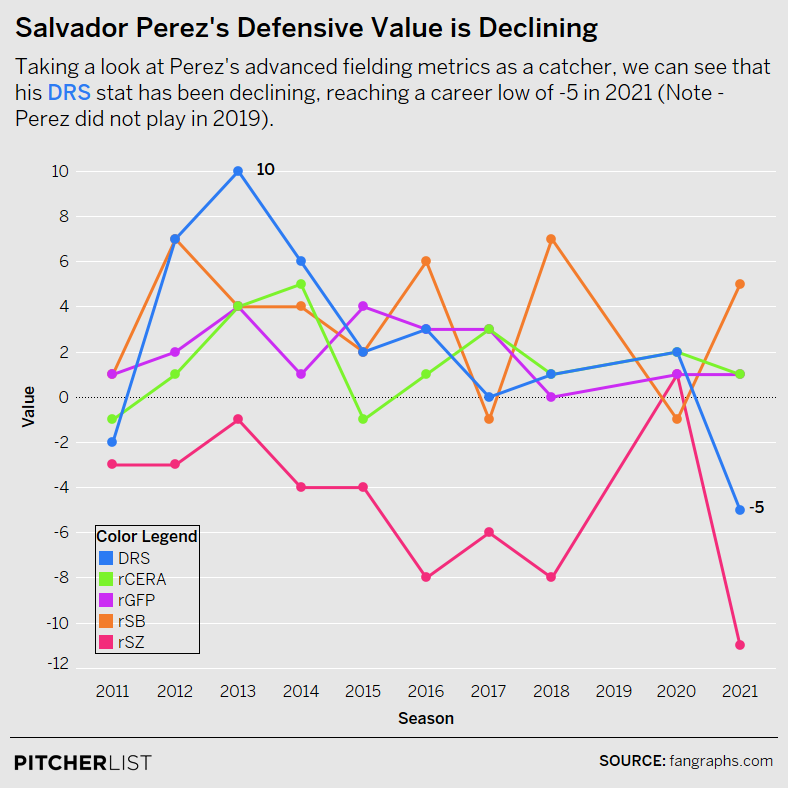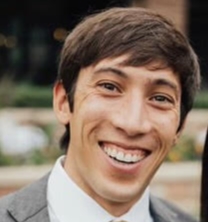Despite the three Gold Gloves he’s earned at catcher, it’s time for Salvador Perez to be a full-time DH. Kansas City needs all the help it can get offensively, and they have young catchers waiting in the wings to fill in behind home plate. The team will get the most of Perez by relieving him of his defensive duties and letting him try to surpass the marks he set with his bat in 2021.
Last year, Perez knocked 48 dingers, outdistancing Johnny Bench’s mark of 45 and supplanting the Hall of Famer as the single-season home run leader among catchers. That record capped off a remarkable season for the 31 year old Venezuelan.
In March 2021, he signed a 4-year, $82 million dollar contract extension with the Royals. His 1000th career hit came in mid-April, and then he was selected as the starting catcher for the AL in the All-Star Game. He went into the All-Star break slashing .275/.300/.501 with 21 HRs, and mashed another 28 in his home run derby debut.
Salvy hit five more home runs after returning from the All-Star Break in July and went on to the best power-hitting month of his entire career in August, when he slashed .268/.348/.649 with 12 home runs in 112 plate appearances.
At a glance, it seems like the 2022 season brought him back down to Earth. As of May 13, he’s slashing .200/.240/.391 in 121 plate appearances with five home runs and seven doubles. However, a closer look at his splits shows his offensive woes aren’t as dire as the top line implies. Here are Perez’s 2022 numbers split out by position, according to Baseball Reference:
The stark difference in Perez’s 2022 numbers when he’s behind the dish compared to when he’s DHing is a continuation of an ongoing trend.
Of the games Salvy played in 2021, he started 40 at DH. That’s 10 more than he played as a DH in 2018 and a far cry more than he played at DH in any other season. 2021 was also the first season in Perez’s career in which he played 161 games, surpassing his previous high of 150 from 2014. He was limited to 142 games or fewer in every prior season due to a combination of injuries and needing rest.
A dive into the season splits shows that giving Salvy a break from catching duties has done wonders for his offensive game. 2018 — the first season he put in significant time as a DH — was also the first season in Perez’s career that his power numbers were higher in the second half of the season than in the first. In previous seasons, his power numbers took a nose dive after the All-Star break.
Here is the visual breakdown of Salvy’s career ISO by season halves to illustrate that trend (data from Fangraphs):

As his time at DH increased from 2018 onward, the second-half slump reversed itself and his performance improved from July onward. Here are his splits for 2018-2021 (note that he missed the 2019 season due to injury, and 2020 was the shortened 60-game season):
In addition to keeping Salvy healthy and maximizing his offensive upside, switching him to DH also minimizes the liabilities of playing him at catcher. Borrowing my colleague’s approach from this article, we can get a holistic view of Perez’s defensive performance by digging into the underlying metrics that contribute to his Defensive Runs Saved (DRS) statistic — the broadest measure of a player’s defensive performance.
Each measure for a component of a catcher’s defensive abilities, Catcher’s ERA (rCERA), Strike Zone Runs Saved (rSZ), Stolen Base Runs Saved Above Average (rSB), and rGFP (Good Fielding Plays Runs Saved) are set against the league average. Negative scores indicate below-average performance, and vice versa (data retrieved from Fangraphs).

What we find is Perez is reliably good-to-great at preventing stolen bases (rSB) and consistently bad at framing pitches (rSZ). His ability to call games and handle his pitchers (rCERA) is steadily above average. The key change that stands out is he’s gotten worse at blocking balls in the dirt and running down flies (rGFP) in the past three seasons, weighing down his defensive value in that time.
The calculus of moving him to full-time DH might be different if Kansas City had a dearth of backups, but that’s not the case. Cam Gallagher provides the team with a serviceable replacement who is a significant upgrade over Perez defensively (at least, over 2021’s version of Perez). For reference, here are the DRS components for each of the Royals’ catchers in 2021:
Along with Gallagher, Sebastian Rivero made his MLB debut last year and played in 17 games, slashing .175/.250/.225. Those numbers don’t sparkle, but he’s only 22 and the Royals have kept him on the roster — clearly they’re excited about his potential. Top prospect MJ Melendez is a third option. He got the callup from AAA Omaha on May 1 due to an injury to Gallagher. He’s hit a respectable .294/.400/.353 in seven games in his first stint in the majors.
If the Royals opt to continue with Perez as their daily backstop in 2022, it won’t be for lack of alternatives. The same cannot be said for their situation at DH.
Last year, Jorge Soler was the Royals’ DH for the first half of the season; then he was traded to Atlanta. With Soler gone, Perez ultimately played 40 games at DH. He mostly shared the position with Ryan O’Hearn (29 games at DH, .225/.268/.369 across all positions) and Carlos Santana (19 games at DH, .214/.319/.342 across all positions).
Hunter Dozier, Hanser Alberto, Adalberto Mondesi and a handful of others all filled in as well. None of them had a tremendous offensive impact on the season. Of that group, Dozier has spent the most time at DH so far in 2022 and is slashing a pedestrian .240/.291/.427 with three home runs as of May 13. To sum this point up bluntly: the Royals didn’t have a reliable alternative to play at designated hitter going into the 2022 season and no one has emerged as a likely candidate so far.
The remaining argument against using Perez as a permanent DH lies in his questionable plate discipline metrics. He strikes out 23.4% of the time and swings at pitches outside the zone 44.6% of the time. It’s easy to imagine he’ll continue regressing to a more pedestrian offensive performance in 2022 given those numbers, but it’s worth taking a closer look at his approach before dismissing his accomplishments.
Fangraphs’ Ben Clemens analyzed Perez’s performance in 2020 and wrote a piece titled What Salvador Perez Does in the Shadow Zone that helps explain his success. The crux of the analysis is he is putting up strong numbers by making hard contact outside the strike zone.
His effectiveness in the shadow/chase zone wasn’t as good in 2021 as it was in 2020, but he made up for that shortcoming by dominating the heart of the zone and by capitalizing on waste pitches he could get his bat to. Here are his Statcast swing profiles from 2020 and 2021 visualizing his approach:


Kansas City’s manager, Mike Matheny, summed up Salvy’s unconventional path to offensive dominance in an interview with MLB’s Anne Rogers:
“He has a different strike zone than everybody else. His strike zone isn’t necessarily what’s going to be called balls and strikes. His strike zone is what can he get a barrel to and hit hard. If he has a good awareness of the limits of that and then becoming more selective, he’s on the right track.”
The Statcast data for 2021 showed that’s exactly what he’s doing. Salvy barreled pitches 16.3% of the time (putting him in the top 7% of the league in that category) and boasted a hard hit percentage of 56.2% (top 1% in the league) in spite of a 33.7% whiff rate.
Given Perez’s new contract, it’s clear Kansas City wants him to be a cornerstone of their squad going forward. They have a plethora of good options at catcher, and a lack of options at DH. Salvy has struggled with injuries throughout his career, and starting more games at DH from 2018 onward seems to have helped him perform in the second half of the season.
It’s best for both Perez and the Royals franchise to limit the amount of time he spends blocking balls in the dirt and allow him to focus on hunting fastballs as they look to compete for the AL Central crown in the coming seasons.
Featured image: photo by Scott Winters/Icon Sportswire, adapted by Jacob Roy (@jmrgraphics3 on IG)
Salvador Perez Defensive Metrics data visualization by @Kollauf on Twitter


The record for HR by a catcher is 42 by Javy Lopez in 2003 (he also hit one as a PH). Only 33 of Perez’s 48 HR came as a catcher and 7 of Bench’s 45 HR in 1970 came at other positions than C.
(The Reds already knew by 1970 that Bench couldn’t keep catching 150 games a year so he spent the entire decade of the 1970’s catching 120-130 games and then playing 20-30 games at other positions before moving to 3B full-time at the very end of his career. He ended up playing every position except 2B and SS (and P) over his career.)